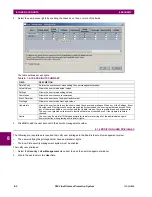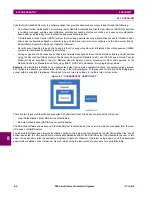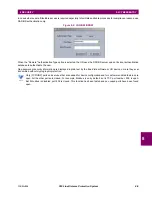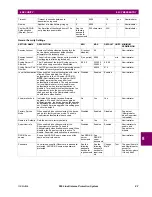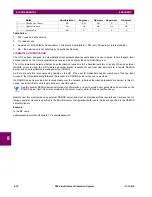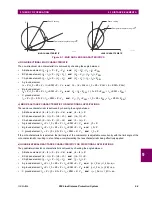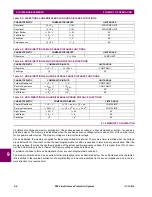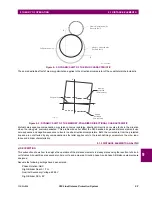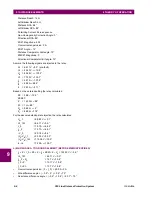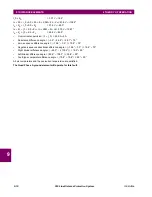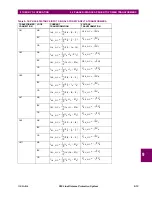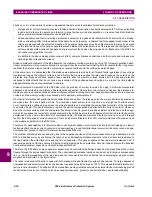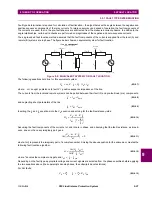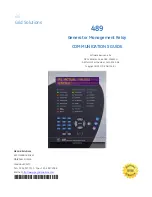
9-6
D30 Line Distance Protection System
GE Multilin
9.1 DISTANCE ELEMENTS
9 THEORY OF OPERATION
9
9.1.4 MEMORY POLARIZATION
All distance functions use memory polarization. The positive-sequence voltage – either memorized or actual – is used as a
polarizing signal. The memory is established when the positive-sequence voltage remains above 80% of its nominal value
for five power system cycles. The memory voltage is a two-cycle old voltage.
Once established, the memory is applied for the user-specified time interval. The memory timer is started when the voltage
drops below 80% of nominal or when the user-programmable condition is asserted to force memory polarization. After the
memory expires, the relay checks the magnitude of the actual positive-sequence voltage. If it is higher than 10% of nomi-
nal, the actual voltage is used; if lower, the memory voltage continues to be used.
A provision is added to force self-polarization from any user-programmable condition.
The memory-polarized mho has an extra directional integrity built-in as illustrated below. The self-polarized mho character-
istic is shifted in the reverse direction for a forward fault by an amount proportional to the source impedance, and in the for-
ward direction for a reverse fault.
Directional
I_0
×
Z
D
V_1M
DIR COMP LIMIT
Directional
I_2
×
Z
D
V_1M
DIR COMP LIMIT
Right Blinder
I
×
Z
R
– V
I
×
Z
R
90°
Left Blinder
I
×
Z
L
– V
I
×
Z
L
90°
Fault-type
I_0
I_2
50°
Zero-sequence
I_0
×
Z
D
–V_0
90°
Table 9–5: NON-DIRECTIONAL MHO PHASE DISTANCE FUNCTIONS
CHARACTERISTIC
COMPARATOR INPUTS
LIMIT ANGLE
Offset mho
I
×
Z – V
V-I
×
Z
REV
COMP
LIMIT
Table 9–6: NON-DIRECTIONAL MHO GROUND DISTANCE FUNCTIONS
CHARACTERISTIC
COMPARATOR INPUTS
LIMIT ANGLE
Offset mho
I
×
Z – V
V-I
×
Z
REV
COMP
LIMIT
Fault-type
I_0
I_2
50°
Table 9–7: NON-DIRECTIONAL QUADRILATERAL PHASE DISTANCE FUNCTIONS
CHARACTERISTIC
COMPARATOR INPUTS
LIMIT ANGLE
Forward Reactance
I
×
Z – V
I
×
Z
COMP LIMIT
Reverse Reactance
I
×
Z
REV
– V
I
×
Z
REV
COMP LIMIT
Right Blinder
I
×
Z
R
– V
I
×
Z
R
90°
Left Blinder
I
×
Z
L
– V
I
×
Z
L
90°
Table 9–8: NON-DIRECTIONAL QUADRILATERAL GROUND DISTANCE FUNCTIONS
CHARACTERISTIC
COMPARATOR INPUTS
LIMIT ANGLE
Forward Reactance
I
×
Z – V
j
×
I_0
×
e
j
Θ
or j
×
I_2
×
e
j
Θ
COMP LIMIT
Reverse Reactance
I
×
Z
REV
– V
–j
×
I_0
×
e
j
Θ
or –j
×
I_2
×
e
j
Θ
COMP LIMIT
Right Blinder
I
×
Z
R
– V
I
×
Z
R
90°
Left Blinder
I
×
Z
L
– V
I
×
Z
L
90°
Fault-type
I_0
I_2
50°
Table 9–4: DIRECTIONAL QUADRILATERAL GROUND DISTANCE FUNCTIONS
CHARACTERISTIC
COMPARATOR INPUTS
LIMIT ANGLE
Summary of Contents for D30D00HCHF8AH6AM6BP8BX7A
Page 10: ...x D30 Line Distance Protection System GE Multilin TABLE OF CONTENTS...
Page 374: ...5 248 D30 Line Distance Protection System GE Multilin 5 10 TESTING 5 SETTINGS 5...
Page 398: ...6 24 D30 Line Distance Protection System GE Multilin 6 5 PRODUCT INFORMATION 6 ACTUAL VALUES 6...
Page 410: ...7 12 D30 Line Distance Protection System GE Multilin 7 2 TARGETS 7 COMMANDS AND TARGETS 7...
Page 444: ...9 24 D30 Line Distance Protection System GE Multilin 9 5 FAULT LOCATOR 9 THEORY OF OPERATION 9...
Page 576: ...B 102 D30 Line Distance Protection System GE Multilin B 4 MEMORY MAPPING APPENDIX B B...
Page 616: ...D 10 D30 Line Distance Protection System GE Multilin D 1 IEC 60870 5 104 PROTOCOL APPENDIX D D...
Page 628: ...E 12 D30 Line Distance Protection System GE Multilin E 2 DNP POINT LISTS APPENDIX E E...
Page 636: ...F 8 D30 Line Distance Protection System GE Multilin F 3 WARRANTY APPENDIX F F...
Page 646: ...x D30 Line Distance Protection System GE Multilin INDEX...

